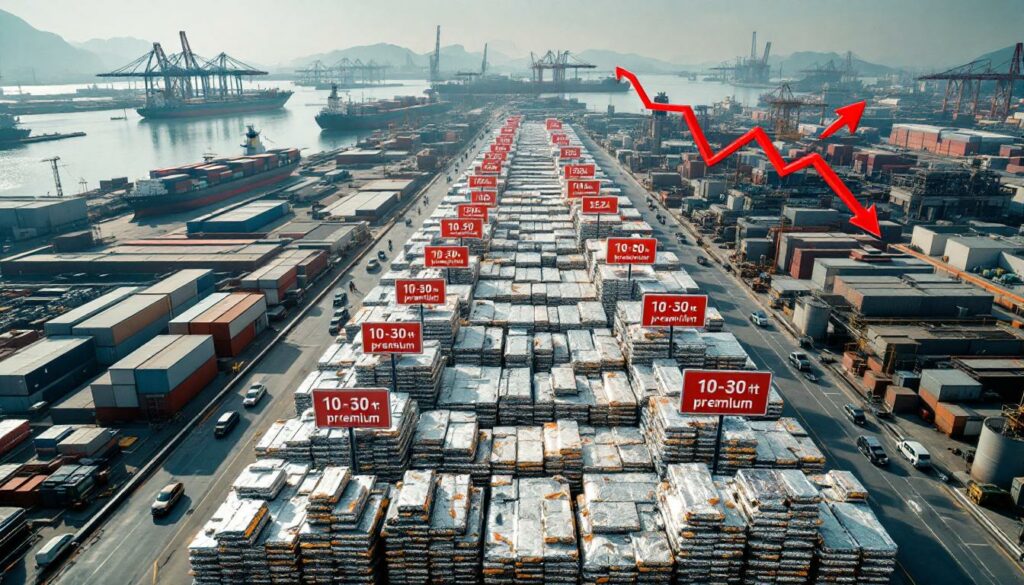Understanding Premiums and Discounts in the Guangdong Zinc Market
In the complex world of metal trading, regional price differentials serve as crucial indicators of localized market conditions. Premiums and discounts in Guangdong zinc market represent specialized pricing mechanisms that reflect the unique supply-demand dynamics of this important industrial hub. These price adjustments, quoted against benchmark prices like the Shanghai Futures Exchange (SHFE), provide valuable signals for traders, manufacturers, and investors navigating China demand trends.
Premiums typically emerge when local demand exceeds available supply, forcing buyers to pay above-benchmark prices to secure material. Conversely, discounts appear when regional oversupply or weak consumption creates buyer-favorable conditions. For metal market participants, these differentials serve as essential barometers of regional market health and trading opportunities.
Key Metrics in Premium/Discount Evaluation
Several critical metrics help market participants evaluate Guangdong's zinc premiums:
- Benchmark comparison: The differential between spot prices and SHFE futures contracts
- Shanghai-Guangdong spread: The price gap between China's two major zinc trading hubs
- Week-over-week changes: The momentum and rate of premium/discount adjustments
- Warehouse inventory levels: Physical stock positions correlating with premium movements
These indicators collectively form a comprehensive picture of Guangdong's zinc market positioning relative to national and international price points. Experienced traders monitor these metrics daily to identify arbitrage opportunities and optimize physical inventory positions.
How Did Guangdong Zinc Premiums Perform This Week?
The Guangdong zinc market experienced significant downward pressure this week, with premiums declining approximately 100 yuan/mt compared to the previous week. Current mainstream quotations for 0# zinc now stand at premiums of just 10-30 yuan/mt against the market—a substantial reduction from the estimated 110-130 yuan/mt recorded in the prior period.
This pronounced weakening represents one of the steepest weekly declines in recent months, signaling deteriorating conditions in the regional spot market. The rapidity of this adjustment suggests accelerating imbalances between physical supply and demand fundamentals.
Shanghai-Guangdong Price Spread Analysis
Despite the sharp decline in Guangdong premiums, the Shanghai-Guangdong price spread remained remarkably stable week-over-week. This unusual pattern—premium collapse without corresponding spread adjustment—indicates that both regional markets are experiencing simultaneous downward pressure rather than Guangdong-specific challenges.
The unchanged spread also suggests limited arbitrage opportunities for inter-regional trading, as the cost-benefit equation for moving material between markets has not significantly improved despite Guangdong's premium contraction.
What Factors Are Driving the Declining Premiums?
The current premium deterioration stems from a classic supply-demand imbalance, with multiple factors converging to create downward price pressure.
Supply-Side Dynamics
On the supply front, Guangdong has experienced a notable month-on-month increase in zinc arrivals, creating an abundant spot cargo environment. This supply surge has overwhelmed the market's absorption capacity, forcing sellers to reduce premiums to attract buyers. Key supply-side factors include:
- Increased shipment volumes into Guangdong warehouses
- Higher spot availability across major trading hubs
- Improved logistics flow from production centers
- Potential destocking by large inventory holders
The concentrated arrival pattern, coupled with limited storage space in key warehouses, has amplified downward premium pressure as traders compete to move material.
Demand-Side Challenges
Simultaneously, demand conditions remain exceptionally weak, with downstream industries exhibiting minimal purchasing enthusiasm. Manufacturing enterprises have adopted strict just-in-time procurement strategies, limiting their inventory exposure and reducing spot market participation. Demand-side constraints include:
- Cautious purchasing behavior from galvanizers and die-casters
- Reduced buffer stocks at manufacturing facilities
- Seasonal slowdown in construction-related consumption
- Export market headwinds for finished zinc products
This consumption weakness has created a buyer's market where consumers can negotiate aggressively on premiums, knowing that sellers face mounting inventory pressures.
How Are Market Participants Responding?
The challenging market conditions have forced both buyers and sellers to adjust their strategies to navigate the current environment.
Trader Strategies and Challenges
Zinc traders face significant difficulties selling inventory amid weak demand conditions. Many are implementing progressive premium reductions to stimulate transactions and manage mounting storage costs. Current trader approaches include:
- Accepting lower margins to maintain cash flow
- Offering flexible delivery terms to attract buyers
- Reducing minimum order quantities to facilitate sales
- Implementing aggressive pricing for larger volume commitments
Despite these efforts, the overall transaction atmosphere remains sluggish, with many traders reporting extended inventory holding periods and deteriorating profitability.
Downstream Consumer Behavior
Downstream consumers have capitalized on the shifting market dynamics, exercising their increased negotiation leverage to secure favorable terms. Buying patterns reflect:
- Opportunistic purchasing only when immediate needs arise
- Aggressive price negotiation for every transaction
- Shortened commitment timeframes to maintain flexibility
- Reduced forward contract volumes to minimize exposure
This cautious approach from consumers reinforces the premium weakness, as buyers feel no urgency to secure material ahead of anticipated needs.
What's the Market Outlook for Guangdong Zinc Premiums?
The near-term outlook for Guangdong zinc premiums appears challenging, with multiple indicators suggesting continued downward pressure in the coming weeks.
Short-Term Forecast
Based on current supply-demand trajectories, premiums are expected to decline further, potentially reaching the 0-20 yuan/mt range. This projection reflects:
- Anticipated continuation of zinc arrivals into Guangdong
- No significant improvement in downstream consumption
- Seasonal factors that typically suppress Q3 demand
- Limited trader ability to withhold material from the market
Without intervention from major market participants or unexpected supply disruptions, the path of least resistance remains downward for regional premiums.
Key Indicators to Monitor
Market participants should closely track several critical indicators to anticipate potential inflection points:
- Incoming shipment volumes: Any reduction could signal supply normalization
- Warehouse inventory trends: Accelerating or decelerating stock builds
- Downstream operating rates: Early signals of consumption recovery
- Premium/discount differentials across grades: Quality spreads often lead market turns
These metrics can provide early warning of changing market conditions before they manifest in headline premium adjustments.
How Does This Compare to Historical Patterns?
While the current premium weakness is notable, placing it in historical context provides valuable perspective on market cycles and seasonal patterns.
Seasonal Trends Analysis
Guangdong zinc premiums typically experience seasonal fluctuations, with Q3 often representing a transitional period between stronger Q2 and Q4 demand. However, the current premium collapse appears more severe than typical seasonal adjustments, suggesting structural rather than cyclical factors.
Historical data indicates that premium recoveries typically begin in late Q3 as manufacturers prepare for Q4 production increases. The absence of early positioning by buyers may indicate deeper concerns about end-market demand or expectations of continued premium weakness.
Correlation with Broader Economic Indicators
The premium deterioration aligns with recent manufacturing PMI softness in China's southern provinces. This correlation underscores the close relationship between industrial activity and regional metal premiums. Other economic factors influencing the current premium environment include:
- Construction sector activity trending below seasonal norms
- Export order weakness for zinc-intensive products
- Elevated financing costs affecting inventory holding decisions
- Subdued consumer confidence impacting durable goods production
These broader economic conditions must improve before a sustainable premium recovery can take hold.
FAQ About Guangdong Zinc Market Premiums
What causes premiums and discounts to fluctuate in regional zinc markets?
Regional premiums and discounts fluctuate based on multiple factors, including:
- Supply chain disruptions: Transportation bottlenecks, production issues, or import restrictions
- Localized demand shifts: Changes in regional manufacturing activity or construction projects
- Warehouse dynamics: Available storage space, financing costs, and warranting policies
- Quality differentials: Availability of specific grades, brands, or shapes
- Arbitrage activity: Trader positioning between different regional markets
The interplay between these factors creates the complex premium environment observed in markets like Guangdong.
How do traders use premium/discount information in their strategies?
Experienced metal traders leverage premium/discount data to:
- Identify regional arbitrage opportunities when spreads exceed transportation costs
- Optimize inventory positioning across different warehouses
- Structure forward contracts to capture expected premium movements
- Adjust physical trading strategies based on premium trends and volatility
- Hedge basis risk between futures and physical positions
Premium intelligence often represents a key competitive advantage for sophisticated trading operations.
What is the relationship between SHFE futures and regional spot premiums?
The relationship between SHFE futures and regional spot premiums reflects the basis risk in the zinc market:
- SHFE futures provide the benchmark price for national pricing
- Regional premiums/discounts reflect local market conditions
- The combined price (SHFE + premium/discount) represents the actual transaction cost
- Changes in futures prices often trigger adjustments in premium levels
- Backwardated or contango futures structures influence premium development
This complex relationship requires traders to monitor both components simultaneously for effective market navigation.
Guangdong Zinc Market in the Broader Context
Comparison with Other Regional Markets
Guangdong's current premium weakness appears more pronounced than in other provincial markets, suggesting localized factors beyond national trends. Key comparative insights include:
- Shanghai premiums typically maintaining a 20-50 yuan/mt premium over Guangdong
- Northern markets showing relatively stronger premium support
- Export-oriented southern markets experiencing similar premium pressure
- Import parity points becoming increasingly relevant as regional premiums compress
These regional differentials create a complex map of price relationships that sophisticated traders must navigate.
Impact on Zinc Supply Chain
The current premium environment has significant implications across the zinc value chain:
- Smelters and refiners: Reduced spot market premiums impact realized prices
- Traders and distributors: Compressed margins and increased inventory risk
- Galvanizers: Opportunity for cost reduction, but potential future supply concerns
- End-users: Short-term pricing benefits, but potential supply chain disruption risks
Market Insight: When premiums collapse rapidly, supply chain participants often become more short-term focused, potentially amplifying commodity trading volatility through collective behavior.
Guangdong Zinc Premium Trend Analysis
| Week | Premium Range (yuan/mt) | WoW Change | Shanghai-Guangdong Spread | Supply Assessment | Demand Assessment |
|---|---|---|---|---|---|
| Current | 10-30 | -100 | Unchanged | Abundant | Weak |
| Previous | 110-130 (estimated) | N/A | Unchanged | Moderate | Weak |
| Forecast | 0-20 (estimated) | -10 to -30 | Stable | Increasing | Continued weakness |
This tabular analysis highlights the progressive deterioration in market conditions and the anticipated continuation of this trend based on current supply-demand fundamentals.
Broader Implications for Metal Market Participants
Strategic Considerations for Different Stakeholders
The current premium environment offers both challenges and opportunities depending on market positioning:
-
For physical traders:
- Focus on inventory turnover rather than margin optimization
- Consider alternative regional markets with stronger premium support
- Evaluate hedging strategies to protect against further premium erosion
-
For manufacturers:
- Capitalize on favorable buying conditions while maintaining minimal inventories
- Consider longer-term contracts at current advantageous levels
- Monitor supplier financial health for potential supply chain risks
-
For investors and analysts:
- View premium weakness as a potential leading indicator for broader zinc market concerns
- Track the premium-to-price ratio for historical comparison points
- Monitor for divergence between premiums and futures prices
Long-Term Market Evolution
While current conditions reflect cyclical weakness, several structural factors may influence Guangdong's zinc premium landscape long-term:
- Infrastructure development shifting demand centers within China
- Evolving environmental regulations affecting regional smelter operations
- Changing trade patterns for both concentrates and refined metal
- Warehouse network optimization by major market participants
Disclaimer: Market conditions can change rapidly based on unforeseen events. While this analysis reflects current information and trends, all price forecast insights involve uncertainty and should be considered alongside other market intelligence sources.
Conclusion: Navigating the Current Premium Environment
The Guangdong zinc premium market presents a challenging environment characterized by supply abundance and demand weakness. Current conditions favor buyers who can capitalize on premium weakness while creating significant challenges for inventory holders and sellers.
Monitoring key indicators—particularly incoming shipment volumes and downstream manufacturing activity—will be essential for anticipating potential market turning points. Meanwhile, the unusual stability in the Shanghai-Guangdong spread despite premium collapse warrants attention as a potential signal of broader market dynamics.
For market participants, the current environment requires careful inventory management, strategic price negotiation, and heightened attention to counterparty risk as premium compression strains trader economics. Furthermore, the ongoing tariff and inflation impacts along with potential trade war impact could further complicate the outlook for metal markets in the region.
Want to Stay Ahead of Major Mineral Discoveries?
Discovery Alert's proprietary Discovery IQ model delivers instant notifications when significant ASX mineral discoveries are announced, providing actionable insights before the broader market reacts. Explore how major discoveries have historically generated exceptional returns by visiting the Discovery Alert discoveries page.




